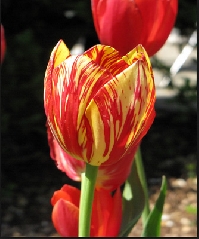
Learn how to plant tulip bulbs so they bloom to add drama to your garden
Tulips are a popular flower among novices and experienced gardeners alike. They?re incredibly easy to grow and they brighten your yard every spring. As with any plant, it?s important to put them in the ground at the right time, ensure they get the right amount of sunlight, drainage and plenty of love.
Learning how to plant tulip bulbs does come with a few footnotes. For instance, they?re categorized as perennials so you?d be correct in assuming they will grow back every year. This often doesn?t happen though.
This flower is native to the Himalaya Mountains so it grows best in regions with hot, dry summers and winters that are quite cold. Home growers may get frustrated when their gorgeous tulip garden doesn?t return, but look on the bright side. Every year you can redesign the flower garden with a new arrangement of colors and patterns.
When to plant them
Tulips are top of mind in spring because that?s when you see they?re beautiful bright blossoms practically everywhere. Unfortunately, spring is already too late to plant your own bulbs. You can try buying a potted one and transferring it to your yard.
Bulbs must be planted in the fall to thrive in the spring. Ideally, the bulbs should not be planted until the ground is about 55 degrees F.
The roots begin to grow as soon as you put them in the ground, but they grow slowly. While winter?s cold temperatures kill most growth above the ground, chilling weather actually stimulates root growth in bulbs. By spring, the roots are stronger and faster growing, so it?s not long after the last snowfall that you?ll see your first bloom.
Where to plant them
Knowing how to plant tulip bulbs means knowing where they will thrive. This flower does best with full sun, but they?ll grow fine in a shady spot with either morning or afternoon sun.
Choose an area with good drainage. The fertile soil should be either slightly acidic or neutral and either dry or sandy. Excessive moisture causes disease, fungus and can even rot the bulbs. Avoid watering the plant bed directly.
Roll up your sleeves
When you?re ready to start digging, space the holes at least 4 to 6 inches apart. This means if you have a lot of bulbs, you?ll need a good-sized plot. Many gardeners like to add small gravel, kitty litter or thorny leaves to the hole with the bulbs to protect them from mice and other pests.
The holes need to be at least 8 inches, but larger bulbs require deeper holes. It?s always a good idea to dig a little deeper to loosen the dirt below where the bulb will be to ensure good drainage.
Place them in the hole with the pointed side up and fill in the hole with soil. Pat the surface with your hands to compress the soil above. While watering the bed isn?t a good idea normally, they do require a small amount of water when first planted.
Long term care
Remember how to plant tulip bulbs next fall when it?s time to start all over again. Some do return, so you may want to plant your second garden in a new spot to see if the tulip bulblets of the first garden return before digging them up. Note that these will never bloom the second spring.
Enjoy the blossoms in spring, but be sure to remove the flowers (this is called dead-heading) once they begin to wilt. Fallen petals can cause fungus or disease. This also redirects the plants energy down below to nourish the new bulbs and divert bulb energy from seed development.
Growing tulips takes time and care, but one glance at the garden in spring will remind you why they?re worth the effort.

